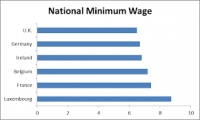National Living Wage Workers Set For £600 Pay Rise From 1 April
Sunday 01 April, 2018 Written by Simon Collyer
Over 2 million people on the National Minimum Wage and National Living Wage will get a pay rise on 1 April when new rates come into force
Full time workers on the National Living Wage will earn over £600 more a year, a total uplift of over £2,000 since the National Living Wage was introduced in 2016
Almost 400,000 young workers are expected to benefit from the fastest increases in the NMW in more than 10 years
Over 2 million people will get a pay rise from today (1 April 2018) thanks to an above-inflation rise in national living and minimum wage rates.
The National Living Wage will go up by 4.4%, from £7.50 to £7.83, meaning a full-time minimum wage worker will be over £2,000 better off since the introduction of the National Living Wage in April 2016. From today the tax-free personal allowance will also increase from £11,500 to £11,850.
Almost 400,000 young workers are expected to benefit from the fastest increases in the National Minimum Wage in more than 10 years.
Business minister Andrew Griffiths said:
“Over 2 million people across the UK will get a step up in pay thanks to today’s rise in the National Living Wage and National Minimum Wage.
“The uplift means a pay rise of over £600 a year for a full time worker on the National Living Wage – that could be two months food shopping or a year’s electricity bills.
“So if you should be getting a rise this month, check your pay, talk to your boss and report underpayment to Acas or HMRC.”
From 1 April 2018 the rates for:
· workers aged 25 and over will be £7.83 per hour
· workers aged 21 to 24 will be £7.38 per hour
· workers aged 18 to 20 will be £5.90 per hour
· workers aged under 18 will be £4.20 per hour
· apprentices under 19 or in the first year of their apprenticeship will be £3.70 per hour
Employers who underpay minimum wage rates can face fines of up to 200% of the back pay they owe to workers and can be publically named by the Department for Business, Energy and Industrial Strategy. Since 2013 the naming scheme has identified more than £9 million in back pay for around 67,000 workers, with more than 1,700 employers fined a total of £6.3 million. Since 2015, the
Government has doubled investment in minimum wage enforcement, spending £25.3 million in 2017 to 2018.
The uplift comes after the Government published its Good Work plan in February, which announced the right to a payslip for all workers. The new law is likely to benefit around 300,000 people who do not currently get a payslip.
For those paid by the hour, payslips will also have to include how many hours the worker is paid for, making pay easier to understand and challenge if it is wrong. The move is part of the Government’s Industrial Strategy the government’s long-term plan to build a Britain fit for the future by helping businesses create better, higher-paying jobs in every part of the UK.
For more information on the National Minimum Wage and National Living Wage and to report underpayment, visit www.gov.uk/checkyourpay or contact Acas for free and impartial advice.
1. The Government takes advice on minimum wage rates from the independent Low Pay Commission, which balances the needs of workers and businesses.
2. Minimum wage rates
| Date | 25 and over | 21 to 24 | 18 to 20 | Under 18 | Apprentice |
| April 2017 | £7.50 | £7.05 | £5.60 | £4.05 | £3.50 |
| April 2018 | £7.83 | £7.38 | £5.90 | £4.20 | £3.70 |
3. Number of people affected by region
| Region | Workers to receive National Living Wage uplift | Young workers to receive National Minimum Wage uplift |
| North East | 78,000 | 22,000 |
| North West | 205,000 | 57,000 |
| Yorkshire & Humber | 156,000 | 34,000 |
| East Midlands | 142,000 | 29,000 |
| West Midlands | 172,000 | 41,000 |
| South West | 127,000 | 32,000 |
| East | 138,000 | 36,000 |
| London | 166,000 | 17,000 |
| South East | 164,000 | 34,000 |
| Wales | 81,000 | 20,000 |
| Scotland | 117,000 | 31,000 |
| Northern Ireland | 80,000 | 26,000 |
| Total | 1,630,000 | 380,000 |
4. The average UK domestic electricity bill is £619 https://www.gov.uk/government/statistical-data-sets/annual-domestic-energy-price-statistics.
5. The average weekly food bill was £58 last financial year according to ONS statistics.

Leave a comment
Make sure you enter all the required information, indicated by an asterisk (*). HTML code is not allowed.
Join
FREE
Here










